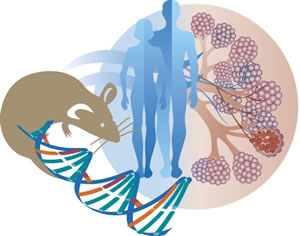Laboratory of Environmental Lung Disease (ELD)
David Schwartz, M.D.
Our group investigates the genetic and biological determinants
of environmental and occupational lung disease. Our research
has provided new insights into the pathophysiology and biology
of asbestos induced lung disease, interstitial lung disease,
environmental airway disease, and innate immunity. We have
identified endotoxin or lipopolysaccharide as an important
cause of airway disease among those exposed to organic dusts,
and that a specific mutation in the Toll-4 gene is associated
with a diminished airway response to inhaled LPS in humans.
Recent work is focusing on the:
- genes that regulate the innate immune response in C.
elegans, mice and humans
- genes involved in the fibroproliferative response in the
lung
- genetic regulation of environmental asthma
The ELD group uses environmental genomics/genetics to understand
the etiology and pathogenesis of asthma, pulmonary fibrosis,
and diseases influenced by innate immunity.
Specifically, the group studies the biology and genetics
of environmental lung disease and host defense. Previous research
has provided insight into the pathophysiology, biology, and
genetics of environmental airway disease, pulmonary fibrosis,
and innate immunity. The Schwartz lab has identified a polymorphism--variation
in the normal sequence of a gene--in TLR4, the receptor for
endotoxin or lipopolysaccharide (LPS). This discovery is important
because the polymorphism in TLR4 results in a blunted response
to inhaled LPS, an enhanced risk of Gram- negative sepsis,
and a decreased risk of atherogenesis in humans. The group’s
current work focuses on identifying other genes that regulate
the innate immune response, genes involved in the fibroproliferative
response in the lung, and the genetic regulation of specific
forms of environmental asthma.
Major areas of research:
- Genes that regulate the innate immune response in Caenorhabditis
elegans, mice and humans
- Genes involved in the fibroproliferative response in
the lung
- Genetic regulation of environmental asthma
- Epigenetics of environmental lung disease
Current projects:
- To use comparative genomics (in vitro, C. elegans, and
mice) and high throughput screening to identify genes involved
in the innate immune response to PAMPs and live organisms
that may be relevant to human host defense.
- To use linkage and association studies in humans with
idiopathic interstitial pneumonia and animal models of pulmonary
fibrosis to identify critical genes involved in fibroproliferation.
- To use genomic expression and epigenetic approaches to
identify key regulatory genes in the development of environmental
airway disease.
David A. Schwartz, M.D. is the Director of National Institute
of Environmental Health Sciences, Director of the National
Toxicology Program, and head of the Environmental Lung Disease
group. Schwartz, a nationally recognized physician-scientist
specializing in environmental lung disease, has authored more
than 150 peer-reviewed research papers, 38 book chapters,
and a textbook. Schwartz earned his BA in biology from the
University of Rochester in 1975, and a medical degree from
the University of California, San Diego in 1979.
Indexing terms: environmental lung diseases, innate immunity,
lipolysaccharides/endotoxin, pulmonary fibrosis, environmental
airway disease, environmental genetics/genomics, and comparative
genomics.
|